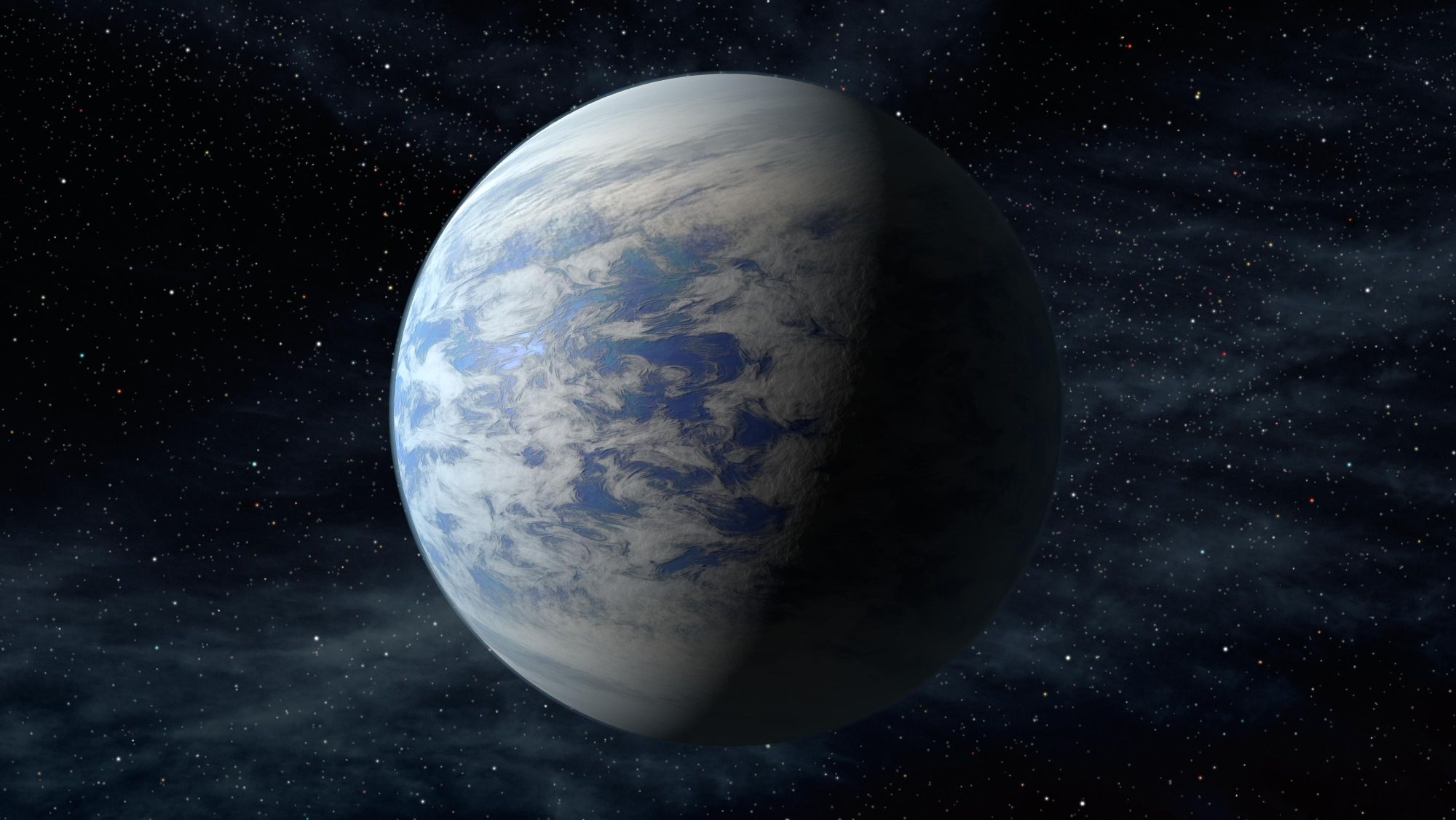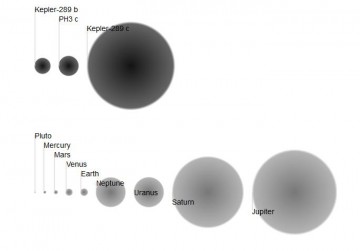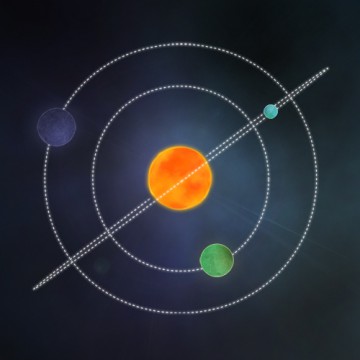
Punctuality is considered one of the basic cultural values of our modern world—there’s simply nothing like being on time. Yet this ability does not necessarily apply to other parts of the Universe. If you were living on exoplanet PH3c for instance, you could always be forgiven for being late. This newly discovered extrasolar world is the first ever to be found with a definite time-keeping problem, exhibiting a highly inconsistent orbital period around its host star that is the result of gravitational influences from two other neighboring planets.
By detecting a characteristic dip in a star’s brightness, which indicates the passage, or transit, of an unseen planet across its disk, NASA’s Kepler space telescope has since its launch in March 2009 helped to revolutionize exoplanetary research by discovering 989 confirmed exoplanets and another 4,178 exoplanet candidates to date, while constantly staring at a fixed field of view in the northern constellations of Cygnus, Lyra, and Draco, which contains approximately 150,000 stars. Although the space telescope was sadly crippled in May 2013 by a malfunction of its second of four gyroscopes that were responsible for keeping it accurately pointed at the same patch of the sky, forcing NASA to eventually implement an alternative two-wheel operation mode earlier this year in order for Kepler to continue its mission, the wealth of science data that has already been returned is continued to be analyzed, leading to new exoplanet discoveries on a constant basis. Scientists are aided in this task by the volunteering efforts of nearly 300,000 members of the public around the world, who monitor small chunks of Kepler data through the Planet Hunters citizen science project, in the hopes of discovering any transit-like features that might be caused by a transiting planet which might have been overlooked by automated search algorithms. Since its launch in December 2010, as part of the Zooniverse web portal, Planet Hunters users have examined more than 22 million Kepler light curves, leading to the discovery of more than 60 exoplanet candidates to date as well as three confirmed ones, including exoplanet Kepler-90f, a member of a tightly packed seven-planet system that has a very similar structure to that of our own Solar System.

In a new study, published in the Oct. 29 online edition of The Astrophysical Journal, an international team of astronomers, led by Joseph Schmitt, an astronomy Ph.D student at Yale University’s Department of Astronomy in New Haven, Conn., and member of the Planet Hunters science team, reports on yet another discovery by the citizen science project, that of PH3c, a distant exoplanet orbiting the young, one-billion-year-old, Sun-like star PH3 (formerly known as Kepler-289), which lies at a distance of approximately 2,300 light-years away and was already known to host two more exoplanet candidates. Yet a very interesting characteristic of PH3c, which makes its discovery newsworthy, is its highly irregular orbital period around its host star, which makes it unique among the other exoplanets that have been discovered to date with the transit detection method. In fact, it is this orbital irregularity that allowed Planet Hunter users to spot PH3c in the first place. By sorting through the Kepler data, the citizen science volunteers detected a series of transits in front of PH3 with a period of 66.06 days, which indicated the presence of a third unknown planet that had originally gone unnoticed by automated transit detection routines. Furthermore, the Planet Hunter volunteers noticed that these transits exhibited a timing variation with an amplitude of five hours, which meant that the passages of the new exoplanet candidate across the face of its host star weren’t exactly periodic, but deviated by approximately 10.5 hours every 10 orbits.
Such transit-timing variations are caused when a planet’s orbit is perturbed by the gravitational tag of other nearby planets, as is the case with Neptune in our Solar System, whose massive gravity slightly affects the orbit of Uranus. The Earth’s orbit is similarly perturbed by the gravity of the rest of the Solar System’s planets, changing its eccentricity over a cyclical period of approximately 100,000 years, but this effect is so miniscule that it amounts to only a few Earth diameters at most in short-term timescales. On the other hand, the orbital perturbations that are observed in the PH3 system can be described as gravitational tugging on the extreme. “If Earth experienced such large changes [like that on PH3c], then if 2014 were 365 days long, 2024 would be 367.4 days long, almost two and a half days longer than 2014,” notes Schmitt at the Planet Hunters blog.
The amplitude of such timing variations depends on the masses of the planets and the eccentricity of their orbits. Consequently, by precisely measuring these variations, scientists can determine the masses, densities, and orbital characteristics of transiting planets and even detect additional non-transiting ones. By doing so, the Planet Hunter science team not only detected PH3c and measured some of its basic properties, but it also confirmed the existence of the other two planets in the system and measured their masses. The first one, named PH3a, orbits its star every 34.54 days at a distance of 0.21 Astronomical Units and is approximately twice as big as Earth and seven times more massive—yet little more is known about the planet’s exact nature. “ … The bulk compositions that are consistent with the measured properties of PH3 b encompass a wide range of possibilities, including rocky planet, water-planet, and hydrogen/helium-enshrouded rocky core scenarios. PH3 b could be a rocky planet with its transit radius de fined by a rocky surface,” writes Schmitt’s team. The newly discovered PH3c orbits slightly more outward at a distance of 0.33 AU and is equally 2.5 times bigger than Earth but is more light-weight, having an estimated mass four times that of our planet. Nevertheless, its density was found to be comparable to that of Jupiter, indicating a similar chemical composition to the latter. “With a density of 1.2 grams per cubic centimeter, PH3 c joins a growing population of low-mass, low-density planets that require signi cant hydrogen/helium gaseous atmospheres,” write the researchers. The third planet, PH3d, orbiting further out at 0.55 AU with a period of 126 days, lies at the regime of the gas giants, being 12 times bigger than Earth and weighting 132 times as much.

Closer examination of the PH3 system showed that in addition to PH3c the outer planet PH3d was also exhibiting transit-timing variations as well, but in the order of minutes instead. “Finding the middle planet was key to confirming the others and allowing us to find their masses,” says Schmitt. “The outer planet’s orbital period also changes slightly, by about 10 minutes. You need to see both planets’ changing orbital periods in order to find out the masses of the planets. One planet doesn’t give enough information.” Furthermore, all planets in the system were found to have orbital period ratios of 1.91 with one another, which meant that the middle planet’s year was 1.91 bigger than that of the inner one and 1.91 shorter than the outer’s. These ratios differ significantly from known orbital resonances, like the 4:2:1 resonances that characterize Jupiter’s Galilean moons and the 2:3 resonance between Pluto and Neptune in our Solar System, as well as those found in other exoplanetary systems that help keep the orbits of these celestial bodies stable for very long periods of time. Yet a series of numerical simulations of the PH3 system’s stability at a timescale of 10 million years showed that all three planets remained in stable orbits without showing any signs of orbital degradation. Nevertheless, the researchers caution that more similar discoveries are necessary before scientists can distinguish whether the observed orbital ratios of the PH3 system are a chance event, or something representative of other planetary systems in general. “More discoveries of low-mass, low-density planets and future theoretical work examining this new population of low-mass, low density planets will be needed to address whether this is a truly a selection effect or a signature of planet formation or migration,” they conclude in their study.
In the meantime, the hundreds of thousands of Planet Hunters volunteers around the world will keep analysing the treasure troves of data that the Kepler space telescope has collected in its four years of operations, leading to even more fascinating discoveries and important insights about our galaxy’s planetary population. “[Planet Hunters] harnesses the human dimension of science,” says Dr. Debra Fischer, a professor of astronomy at Yale University and co-author of the study. “Computers can’t find the unexpected, but people can, when they eyeball the data.“I think we’ll be able to contribute some really unique science this way.”
Want to keep up-to-date with all things space? Be sure to “Like” AmericaSpace on Facebook and follow us on Twitter: @AmericaSpace




Another great article, Leonidas! The growing list of “low-mass low-density” planets like this also have huge implications for the maximum size of terrestrial-type planets and their potential habitability. Several statistical analyses of the mass-radius relationship of extrasolar planets found in the Kepler data base have been published over the past year. These studies show a distinct transition in density that occurs at a radius of no greater than 1.6 times that of Earth (corresponding to a mass of no greater than 6 times that of Earth) indicating that planets larger than this are most likely mini-Neptunes or gas dwarfs. This means that the vast majority of extrasolar planets that have been touted as being “potentially habitable” are not even terrestrial planets never mind potentially habitable.
http://www.drewexmachina.com/2014/07/24/habitable-planet-reality-check-terrestrial-planet-size-limit/
Thank you Andrew! Indeed, as your blog post explains in great detail, the evidence currently supporting the notion that the so-called ‘potentially habitable’ exoplanets that have been discovered to date are in fact that, are highly circumstantial and only rely on our current understanding of habitability relative to each planet’s mass, radius and orbital position from their host star.
Indeed,it’s hard to imagine how an exoplanet with a mass greater than four times that of the Earth can be a rocky analog of our own planet. On the other hand, the observing capabilities of today’s ground and space-based instruments limit the types of extrasolar worlds we can currently observe, to no smaller than the Neptune and Super-Earth-like ones. I believe that future space telescopes like the James Webb and the TESS planet-hunting mission will lead to a new age of exoplanet discoveries, finally allowing us to observe the true extrasolar Earth-analogs out there.
Having said that, even if most of the already discovered exoplanets inside their host stars’ habitable zone aren’t themeselves habitable, there’s nothing to exclude the possibility of potentially habitable exomoons in orbit around these worlds. Yet, the discovery of such moons, if they exist, awaits the launch of the aforementioned space missions. We shouldn’t also exclude the possiblity of potentially habitable rocky ‘Super Earths’ outside of their stars’ habitable zones as well, as explored in a study that was published earlier this year on the Astrobiology journal.
http://www.americaspace.com/?p=51369
Kind regards!